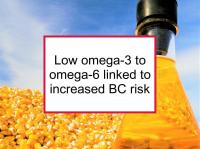While both omega-3 and omega-6 fats are essential for health, the typical U.S. diet contains an abundance of omega-6 fatty acids, whereas consumers have to make a point of consuming food sources of omega-3s. A low dietary omega-3 to omega-6 fatty acid ratio is associated with increased breast cancer risk.
In fact, this ratio has been found to be related to breast cancer risk whereas the absolute level of omega-6 fats has not. It has been suggested that an omega-3 to omega-6 ratio of one-to-two or greater is ideal, although no studies have specifically examined the influence of such a high ratio on breast cancer risk. Now a new study has reported that women with relatively high breast cancer risk tend to have low omega-3 to omega-6 tissue levels.
High omega-6 and omega-3 foods
Commercially produced food and restaurant food tend to have relatively high levels of omega-6 fats. Processed food companies and restaurant chains participating in the ongoing move away from partially-hydrogenated oils typically are substituting other oils. However, these oils contribute to the typically high levels of omega-6 fatty acids in our diets.
The most common omega-6 fatty acids are arachidonic acid (found primarily in meat and meat products) and linoleic acid (found in vegetable oils). Linoleic acid is converted into arachidonic acid in the body.
High omega-6 oils
High omega-3 foods
Many women will find it difficult to improve their omega-3 to omega-6 ratio without taking fish oil supplements. Good quality fish oil supplements (with low levels of heavy metals but not overly refined) appear to be beneficial for breast cancer survivors overall, based on available evidence. However, women undergoing chemotherapy should avoid fish oil supplements. Two uncommon fatty acids found in small amounts in some fish oil supplements can block chemotherapy's intended effects. Unfortunately, consumers are not in a position to know which fish oil preparations contain these fatty acids.
Latest research links low omega-3 to omega-6 to increased risk
The study referenced at the beginning of this news story was designed to investigate the association between omega-3 and omega-6 fatty acid levels in blood and breast tissue and breast cancer risk. The ratio of omega-3 to omega-6 fats, in particular, the ratio of the marine omega-3 fatty acids eicosapentaenoic acid (EPA) and docosahexaenoic acid (DHA) to arachidonic acid, is known to be inversely related to risk of breast cancer.
To conduct the study, the authors obtained blood and benign breast tissue samples from 70 women with elevated breast cancer risk using random periareolar fine needle aspiration (RPFNA). The fatty acid composition of red blood cell, plasma and breast phospholipids and plasma and breast triaclyglycerides were determined as percentage by weight. The authors used the presence of cytologic atypia (abnormal but not malignant cells) as a biomarker of increased breast cancer risk. The National Cancer Institute's Food Frequency Questionnaire was also used to assess dietary intake. Study participants were found to have a median daily intake of EPA+DHA of 80 mg and total omega-3 fat intake of 1.1 g. The median total omega-3 to total omega-6 intake ratio was one to 10 (1:10).
Women with cytologic atypia were found to have lower levels of omega-3 fats in red blood cell and plasma phospholipids, as well as lower omega-3 to omega-6 ratios in plasma triaclyglycerides and breast triaclyglycerides compared to women without atypia. The EPA+DHA to arachidonic acid ratio in plasma triaclyglycerides was also found to be lower in women with atypia. The authors comment that this is the first study to report associations between tissue levels of omega-3 and omega-6 fatty acids and a reversible biomarker of breast cancer risk (cytologic atypia). The study technique could be used in breast cancer prevention trials of omega-3 fatty acid supplementation.
